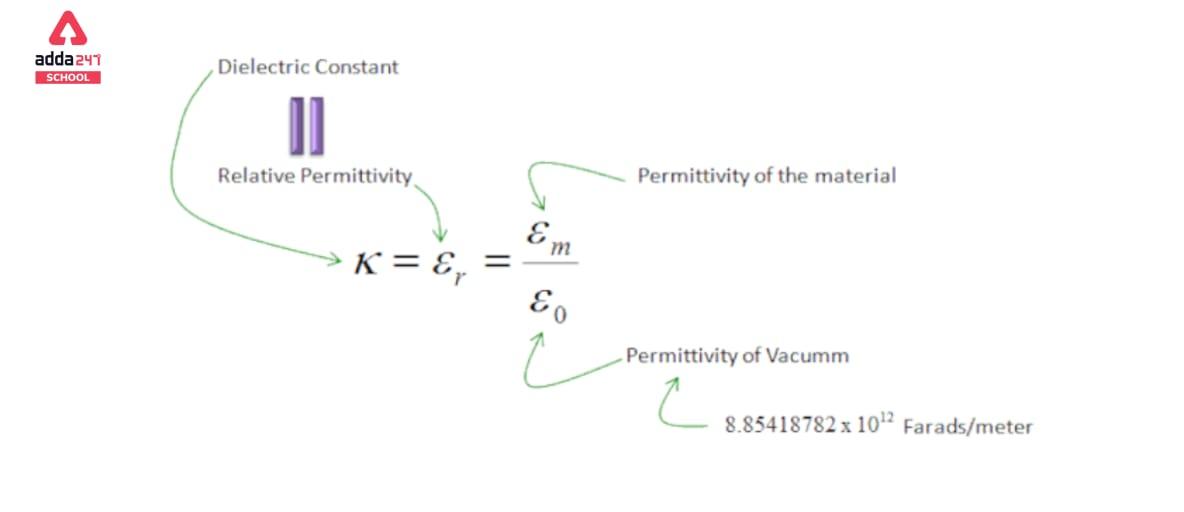Table of Contents
Dielectric Constant
A dielectric is a substance with low electrical conductivity that also has the ability to store electrical charge (due to Dielectric polarization). As a result, it exhibits only displacement current, making it perfect for use in the construction of a capacitor to store and return electrical energy.
Dielectric Constant Definition
The dielectric constant, also known as the relative permittivity or simply ε (epsilon), is a fundamental property of a material that describes its ability to store electrical energy in an electric field. It is a dimensionless quantity and represents the ratio of the electric displacement field (D) to the electric field (E) applied to the material.
Formula of Dielectric Constant
Mathematically, the dielectric constant (ε) is defined as:
ε = D / E
In simpler terms, the dielectric constant tells us how much the presence of the material affects the electric field passing through it. It quantifies the extent to which a material can polarize (align its electric dipoles) under the influence of an external electric field.
In a vacuum or free space, the dielectric constant is equal to 1. For most materials, the dielectric constant is greater than 1, indicating that they can increase the electric field within them compared to what it would be in free space.
Higher dielectric constant materials are commonly used in capacitors and other electronic components to increase their capacitance and energy storage capabilities. Dielectric materials are also employed to reduce electric field concentrations, prevent electrical breakdown, and improve the efficiency of various electrical devices and systems. Different materials have different dielectric constants, and the value of the dielectric constant can vary significantly depending on the nature of the material and its composition.
What is Dielectric Constant in Chemistry & Physics
The dielectric constant in chemistry is an important parameter to consider when describing a capacitor. An electronic component called a capacitor is used to store electric charge. A dielectric insulating plate is sandwiched between the metal conducting plates in most cases. The dielectric property of a capacitor is critical to its operation.
Dielectric Constant Symbol
The capacitor’s ability to store charge is determined by the dielectric material layer. It’s critical to choose the correct dielectric material. As a result, it can be defined as the ratio of the electric field without a dielectric(E0) to the net field with a dielectric(E).
| κ = ?/ ?0 |
E0 is always bigger than or equal to E in this case. As a result, a dielectric constant’s value is always greater than 1.
More charge can be stored in a capacitor with a higher value of κ.
Formula of Permittivity- Dielectric Constant Formula
Check formula of permittivity and dielectric constant formula which is mathematically expressed as:
| κ = ?/ ?0 |
Where,
- κ à dielectric constant
- ? à permittivity of the substance
- ?0 à permittivity of the free space
Dielectric constant is a unitless, dimensionless quantity since it is the ratio of two like entities. The Dielectric Constant, denoted by the Greek letter kappa ‘κ’, is the relative permittivity of a dielectric substance..
Factors Affecting Dielectric Constant
The dielectric constant depends on various factors such as:
- One of the elements affecting dielectric constant is the frequency of the applied voltage. The value of the dielectric constant becomes non-linear as the frequency of the applied voltage increases.
- When a direct current voltage is applied, the dielectric constant value decreases, however when an alternating current voltage is applied, the dielectric constant value increases.
- Temperature: When the temperature is low, the molecules in the dielectric substance have a difficult time aligning. The dipoles in the dielectric material become dominant as the temperature rises, resulting in an increase in the dielectric constant. The transition temperature is the temperature at which something changes from one state to another. If the temperature climbs over the transition temperature, the dielectric constant will gradually drop.
- Humidity and moisture: As humidity and moisture levels increased, the dielectric material’s strength reduced.
- Heating effect: Dielectric loss occurs when the dielectric substance is heated. When a material is subjected to an alternating current voltage, dielectric loss is defined as the dissipation of energy in the form of heat due to movement of the molecules in the material. As the substance absorbs electrical energy, this happens.
- The dielectric constant is also influenced by the material’s structure and shape.
- The dielectric constant is also affected by the material’s deterioration and weathering.
Dielectric Constant of Vacuum Glass
In general, the dielectric constant is the ratio of a substance’s absolute permittivity to the absolute permittivity of free space. Liquid water has a dielectric constant of roughly 78.4 at room temperature.
Dielectric Constant of Water
In general, the dielectric constant is the ratio of a substance’s absolute permittivity to the absolute permittivity of free space. Glass has a dielectric constant of roughly 5-10 at room temperature.
Related Post:
- Cannizzaro Reaction – Definition, Examples, Mechanism
- Lifecycle Of Silkworm- Diagram, Drawing, Project
- Scattering Of Light- Examples, Definition, Discovery, Prism
- Aufbau Principle Definition, Formula, Example, Limitation
- Area Of Sphere- Formula In Maths
- Rank Of The Matrix – Definition, Formulas, Examples



 NEET City Intimation Slip 2025 Release D...
NEET City Intimation Slip 2025 Release D...
 CUET UG Date Sheet 2025 @cuet.nta.nic.in...
CUET UG Date Sheet 2025 @cuet.nta.nic.in...
 UP, MP, CBSE Board Result 2025 Live Upda...
UP, MP, CBSE Board Result 2025 Live Upda...










